
Shiraz is the fifth-most-populous city of Iran and the capital of Fars Province, which has been historically known as Pars and Persis. As of the 2016 national census, the population of the city was 1,565,572 people, and its built-up area with Sadra was home to almost 1,800,000 inhabitants. A census in 2021 showed an increase in the city's population to 1,995,500 people. Shiraz is located in southwestern Iran on the rudkhaneye khoshk seasonal river. Founded in the early Islamic period, the city has a moderate climate and has been a regional trade center for over a thousand years.
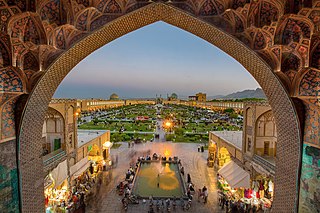
Isfahan, from its ancient designation Aspadana and, later, Spahan in middle Persian, rendered in English as Ispahan, is a major city in the Greater Isfahan Region, Isfahan Province, Iran. It is located 439.78 kilometres south of Tehran and is the capital of Isfahan Province. The city has a population of approximately 2,220,000, making it the third-largest city in Iran, after Tehran and Mashhad, and the second-largest metropolitan area.

The Golestan Palace, also transliterated as the Gulistan Palace and sometimes translated as the Rose Garden Palace from Persian language, was built in the 16th century, renovated in the 18th century and finally rebuilt in 1865. It is the former official royal Qajar complex in Tehran.

Qazvin is the largest city and capital of the Province of Qazvin in Iran. Qazvin was a capital of the Safavid dynasty for over forty years (1555–1598) and nowadays is known as the calligraphy capital of Iran. It is famous for its traditional confectioneries, carpet patterns, poets, political newspaper and Pahlavi influence on its accent. At the 2011 census, its population was 381,598.

Kashan is a city in the northern part of Isfahan province, Iran. At the 2017 census, its population was 396,987 in 90,828 families.

Iranian architecture or Persian architecture is the architecture of Iran and parts of the rest of West Asia, the Caucasus and Central Asia. Its history dates back to at least 5,000 BC with characteristic examples distributed over a vast area from Turkey and Iraq to Uzbekistan and Tajikistan, and from the Caucasus to Zanzibar. Persian buildings vary from peasant huts to tea houses, and garden pavilions to "some of the most majestic structures the world has ever seen". In addition to historic gates, palaces, and mosques, the rapid growth of cities such as the capital Tehran has brought about a wave of demolition and new construction.

Ali Qapu Palace or the Grand Ali Qapu is an imperial palace in Isfahan, Iran. It is located on the western side of the Naqsh-e Jahan Square, opposite to Sheikh Lotfollah Mosque, and had been originally designed as a vast portal entrance to the grand palace which stretched from the Naqsh-e Jahan Square to the Chahar Baq Boulevard. The palace served as the official residence of Persian Emperors of the Safavid dynasty. UNESCO inscribed the Palace and the Square as a World Heritage Site due to its cultural and historical importance. The palace is forty-eight meters high and there are six floors, each accessible by a difficult spiral staircase. In the sixth floor, Music Hall, deep circular niches are found in the walls, having not only aesthetic value, but also acoustic. Ali Qapu is regarded as the best example of Safavid architecture and a symbol of Iran's Islamic heritage.

The arts of Iran are one of the richest art heritages in world history and encompasses many traditional disciplines including architecture, painting, literature, music, weaving, pottery, calligraphy, metalworking and stonemasonry. There is also a very vibrant Iranian modern and contemporary art scene, as well as cinema and photography. For a history of Persian visual art up to the early 20th century, see Persian art, and also Iranian architecture.
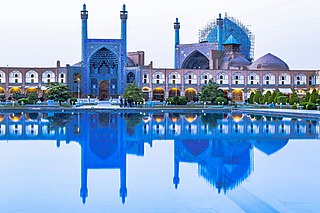
The Shah Mosque is a mosque located in Isfahan, Iran. It is located on the south side of Naghsh-e Jahan Square. It was built during the Safavid dynasty under the order of Shah Abbas I of Persia.

Qajar art refers to the art, architecture, and art-forms of the Qajar dynasty of the late Persian Empire, which lasted from 1781 to 1925 in Iran (Persia).

Kashan County is located in Isfahan province, Iran. The capital of the county is Kashan. At the 2006 census, the county's population was 297,000, in 81,816 households. At the 2016 census, the county's population was 364,482, in 112,258 households.

Safavid art is the art of the Iranian Safavid dynasty from 1501 to 1722, encompassing Iran and parts of the Caucasus and Central Asia. It was a high point for Persian miniatures, architecture and also included ceramics, metal, glass, and gardens. The arts of the Safavid period show a far more unitary development than in any other period of Iranian art. The Safavid Empire was one of the most significant ruling dynasties of Iran. They ruled one of the greatest Persian empires since the Muslim conquest of Persia, and with this, the empire produced numerous artistic accomplishments.

The East-Azerbaijan Provincial Palace is the main office for Iran's East-Azerbaijan provincial governor in downtown Tabriz. The history of the palace goes back to the Safavid and Zand dynasties, when it was named Aali Qapou. The original construction of the palace was supervised by Najaf Qoli Khan for the Safavid kings, when Tabriz was the capital of Iran. During the Qajar era, Aali Qapu served as the residence for the crown prince of Iran. It was reconstructed and repaired under Naser al-Din Shah, during which its name was changed to Shams ol-Emareh. Since the Iranian Constitutional Revolution, the palace has been used as the provincial governorship office.
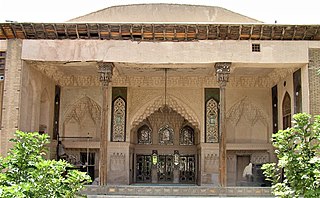
The Sheykh ol-Eslam's house is a historical house in Isfahan, Iran. Built during the Qajar era, the house is built on the northern and southern sides of the large yard. The reason for this unusual plan, which is completely different from other historical houses in Isfahan, is that the yard had been built originally as a Tekyeh for religious ceremonies. The main parts of the structure are on the southern side of the yard behind a veranda. Stucco, decorations with cut mirrors and muqarnas have made this part of the house much more prominent. There is a big reception hall with two rooms behind the southern veranda, and there is a Howz and two small flower garden opposite the northern veranda. In the southwestern part of the house, there is a small courtyard, which is connected to the main courtyard by a narrow corridor.
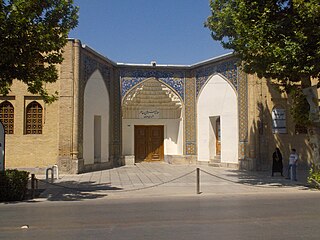
The museum of decorative arts in Isfahan was founded in 1995. More than 3000 artworks from the Safavid and Qajar era are kept in the museum. The building of the museum belongs to the era of Abbas I. The building was constructed during the era of Abbas I as a part of Charbagh Palace. There is a multi-storey tower beside the museum, which belongs to the Qajar era. The tower was used at first as watchtower and then as jail. The tower does not have any kind of decorations, bit it is regarded as a notable relic of the Safavid architecture.

Persian art or Iranian art has one of the richest art heritages in world history and has been strong in many media including architecture, painting, weaving, pottery, calligraphy, metalworking and sculpture. At different times, influences from the art of neighbouring civilizations have been very important, and latterly Persian art gave and received major influences as part of the wider styles of Islamic art. This article covers the art of Persia up to 1925, and the end of the Qajar dynasty; for later art see Iranian modern and contemporary art, and for traditional crafts see arts of Iran. Rock art in Iran is its most ancient surviving art. Iranian architecture is covered at that article.

The following is a timeline of the history of the city of Isfahan, Iran.
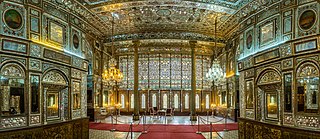
Āina-kāri is a kind of interior decoration made by Iranian artists who assemble finely cut mirrors together in geometric, calligraphic or foliage forms. This creates a beautiful shining surface covered with complex facets, reflecting light as intricate abstract patterns or glittering reflections. Beside their decorative use, this art is used as a strong durable cover for an interior space of a building.

Sussan Babaie is an Iranian-born art historian and curator. She is best known for her work on Persian art and Islamic art of the early modern period. She has written extensively on the art and architecture of the Safavid dynasty. Her research takes a multidisciplinary approach and explores topics such as urbanism, empire studies, transcultural visuality and notions of exoticism. In her work as a curator, Babaie has worked on exhibitions at the Sackler Museum of Harvard University (2010), the University of Michigan Museum of Art, and the Smith College Museum of Art (1998).

Tulip period architecture was a stage in Ottoman architecture in the early 18th century. New types of decoration were introduced into the existing classical style of Ottoman architecture and new types of buildings, such as stand-alone fountains and libraries, became important landmarks. The style is most closely associated with the Tulip Period (1718-1730), a period of peace during the reign of Ahmed III when architectural patronage increased in Istanbul after a relative lull in the late 17th century. However, the new style was also present at the beginning of Ahmed III's reign and continued to be evident after him in the 1730s. The introduction of European influences in Ottoman culture and architecture eventually led to the creation of the Ottoman Baroque style in the 1740s.





















